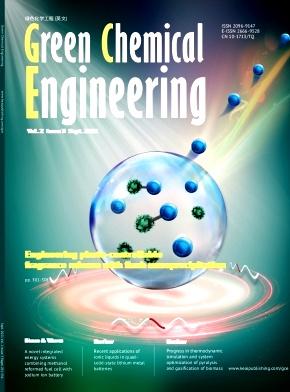利用沼渣衍生生物炭进行可调节 pH 值的同步选择性染料废水修复:吸附行为、机理认识和潜在应用
IF 7.6
Q1 ENGINEERING, CHEMICAL
引用次数: 0
摘要
利用生物炭吸附有机污染物已成为污水修复研究的一个重要组成部分。在本研究中,利用消化液制备的生物炭进行硝酸功能化,以提高其对合成废水中亚甲基蓝和甲基红有机染料混合物的吸附能力。实验结果表明,在最佳条件下,具有微介孔结构、比表面积为~ 454.15 m2/g的改性生物炭BC750_NM具有最佳的吸附性能。在pH控制下,该吸附剂表现出选择性和同步的染料吸附,这主要归因于介质中的多重相互作用过程。值得注意的是,在酸性条件下,亚甲基蓝和甲基红的吸附率均接近90%,而在碱性条件下,亚甲基蓝优先于甲基红,对亚甲基蓝的吸附率达到100%。我们的方法不仅为减轻水污染提供了宝贵的资源,而且为消化系统管理提供了可持续的解决方案,展示了创新技术产生协同环境解决方案的潜力。本文章由计算机程序翻译,如有差异,请以英文原文为准。

pH-tuneable simultaneous and selective dye wastewater remediation with digestate-derived biochar: adsorption behaviour, mechanistic insights and potential application
The use of biochar for organic pollutants adsorption has emerged as a key component in wastewater remediation research. In this study, biochar prepared from digestate was subjected to nitric acid functionalization to enhance its adsorption capacity for organic dye mixtures of methylene blue and methyl red in synthetic wastewater. Based on experimental evidence, modified biochar BC750_NM, with a micro-mesoporous structure and a specific surface area of ∼454.15 m2/g had the best adsorption performance at optimum conditions. This adsorbent exhibited both selective and simultaneous dye adsorption upon pH control, mainly attributable to a multi-interaction process in the medium. Notably, the adsorption of both methylene blue and methyl red approached 90% under acidic pH, while methylene blue was preferentially adsorbed over methyl red at alkaline pH to attain an excellent adsorption rate of 100% for methylene blue. Our approach not only yields a valuable resource for mitigating water pollution but also offers a sustainable solution for digestate management, showcasing the potential for innovative techniques to produce synergistic environmental solutions.
求助全文
通过发布文献求助,成功后即可免费获取论文全文。
去求助
来源期刊

Green Chemical Engineering
Process Chemistry and Technology, Catalysis, Filtration and Separation
CiteScore
11.60
自引率
0.00%
发文量
58
审稿时长
51 days
 求助内容:
求助内容: 应助结果提醒方式:
应助结果提醒方式:


